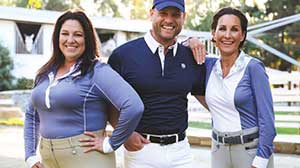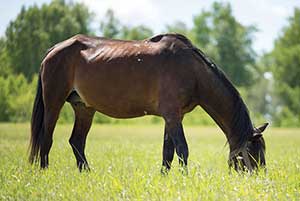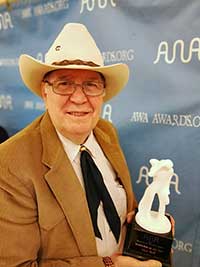Tack & Farm
Our Tack & Farm section features an Apparel section to find both practical and fashionable riding attire. If you ride English & Western or Race, many sources are available in the Tack section.
Building a barn? Need an architect for your equine dream home? Find one in Barns & Stalls.
Have a hungry horse? Of course you do! Find a place to buy your feed and tuck your horse in at night in the Bedding & Feed section. Looking for a place to keep your horse? You can find it in the Horse Boarding section. Keep your horse happy and beautiful with resources in our Grooming section.
Traveling? Find a Shipping company or Horse Sitting service if your horse is staying home!
Running and maintaining a farm or stable is a continuous effort, and to help find products or tools you need, please see our Equipment, Fencing and Management Tools sections.
Seeking Services? Find financial and tax expertise in our Accounting section. Companies who will help protect your investment are found in the Insurance section. For those who want legal advice about purchasing, liability, and other issues, please look at the Equine Law section to find an expert. Build and promote your business with teams from Marketing / Videography / Web Design.
Do we need to add more? Please use the useful feedback link and let us know!

by Nikki Alvin-Smith for Horizon Structures Presents Series
It’s true that good things come in small packages and horses are no different. But what about their housing needs? When it comes to the choice of stabling, owners of the smaller equus breeds face different challenges than those of the horse owner.
For this author the pleasure of owning and riding donkeys set a career with horses in motion. This is probably true for many equestrians. The smaller species of equus is more accessible for grooming and caretaking for a child, and is a better fit when it comes to riding too. Less intimidating to a child than their horse or pony sized counterparts, the donkey or miniature offers a cuddly bundle of joy.
When I was 10 years old my family and I headed down to the Cotswold region of Gloucestershire, England to purchase my first pony. I was beyond excited. We entered the driveway to the stud and saw donkeys and ponies galore in the fields alongside the car, and when my parents, kid brother and I sat with the farm owner in his office to discuss our equine needs, I was certain a new pony was coming home to me soon.
Read more: Horse Barn Modification for Miniatures, Mules and Donkeys

by Lauren Mauldin
Some things will always be consistent on the hunter/jumper circuit: fashion trends grab attention with innovative designs and intricate details, and life will throw a curveball to your plans.
Right now, a lot of trendy attire comes from Europe. Technical fabrics and micro-crystals have squeaked into tradition. There are tons of colors available and seemingly infinite ways to customize your turnout. Big warmbloods and tiny European breeches—that’s “the look,” right? While they have endless options for trim, details and color, many of the popular European brands are a lot less inclusive in terms of sizing. The advice from the tack store is usually, “Size up,” but unless you’re already a small size, there’s not much room to go.
That curveball I mentioned? It doesn’t just apply to surprise abscesses and bad weather. Our bodies, especially women’s, take a beating. There are injuries, babies, genetics—so many reasons we have a hard time fitting into those beautiful (but extremely unrealistic for some of us) European breeches. The International Journal of Fashion Design, Technology and Education revealed that the average size of an American woman is now between a 16 and 18. Yet, despite the knowledge that fitness and riding talent prevails at a wide variety of sizes, it’s still hard to find breeches larger than a 32 at many equestrian retailers.
Read more: 3 Companies That Excel at Outfitting Equestrians of All Sizes

Amanda Grev, Craig Sheaffer, and Krishona Martinson
The authors are a graduate research assistant, agronomy professor, and extension equine specialist, respectively, at the University of Minnesota.
With one of the greatest expenditures of horse ownership being feed costs, horse owners often look for ways to reduce these costs. Pastures can provide a lower cost source of forage for horses compared to hay or other purchased feeds, and has the capability to meet or exceed the dietary requirements for many categories of horses. Therefore, maximizing pasture productivity can be a valuable tool for reducing feed costs.
In the Upper Midwest, cool-season perennial grasses are the foundation of productive horse pastures. However, there may be opportunities to utilize alternative forages such as annual cool-season grasses to extend the grazing season earlier in the spring or later in the fall. In addition to extending the grazing season, annuals can be used to provide forage in emergency grazing situations when perennial forages are lost following winterkill, floods, or drought.

Some folks might think that Alan Bell picked the wrong profession. Instead of making custom cowboy boots, which Bell has done for 40-plus years out of a one-time barbershop in Abilene, Texas, he could’ve been a stand-up comedian or a TV talk-show host. Imagine Johnny Carson (if you remember Johnny Carson) with a deep Texas drawl.
Here’s Bell:
On his hometown of Blackwell, Texas – “It’s so small that the city limits sign is on one board.”
On the pair of boots he’s wearing – “I’m wearin’ an ol’ worn-out pair of boots that I should’ve thrown in the trash. I need boots worse than any customer that I know.”
On his shop – “It looks like we’re a family of vagabonds.”
- The Correct Way to Use Slow-Feeders
- Don Gonzales: Texas Saddlemaker, Leathercraft Teacher
- 4 Ideas for Advertising and Marketing Your Equestrian Center
- Why Outdoor Living is Better for Your Mare!
- Horizon Structures Presents: Barn Color Choice Matters
- Only Skin Deep? That Old Chestnut of Saddle Fitting – and Chestnut Horses
- This Saddle Is the Answer to My Prayers!
- Horse Barn Warranties Matter
- Equilume research shows Blue Light reduces bacterial and fungal growth
- An Old Horse Barn is Transformed into a Guest House
































